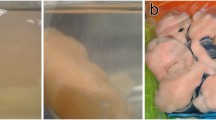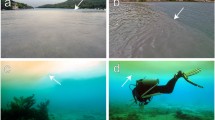Abstract
Bacterial productivity in sandy sediments on reef flats at Lizard Island, Great Barrier Reef was determined from the rate of incorporation of tritiated thymidine into DNA. The study was conducted during January 1982 and July 1983. A small diurnal increase occurred in sediments having a dense population of microalgae. Bacterial production was 120 to 370 mg C m-2 d-1 in summer on reef flats, which was equivalent to 30–40% of primary production by benthic microalgae. In winter, rates of primary production by benthic microalgae and secondary production by bacteria were about one-half to one-fifth of those in summer. There was much variation in production, due to patchiness in the distribution of benthic microbes, especially microalgae. Doubling times for the bacteria in surface sediment were 1 to 2 d in summer and 4 to 16 d in winter on the reef flats. These high productivity values for bacteria indicated that a net input of organic matter to the sediment was needed to support the growth of bacteria. Sediment bacteria thus have a very important role in transforming organic matter on the reef flats. Grazing by Holothuria atra depressed both primary production and bacterial production. It was estimated that these holothurians ate about 10 to 40% of bacterial carbon produced each day in summer, and thus have an important role in the carbon cycle. Harpacticoid copepods were numerically important components of the benthic meiofaunal community and probably had a significant impact on bacterial density as grazers.
Similar content being viewed by others
Literature cited
Bakus, G. J.: The biology and ecology of tropical holothurians. In: Biology and geology of coral reefs. Vol. 2. Biology 1, pp 325–67. Ed by O. A. Jones and R. Endean. Academic Press: New York 1973
Banse, K.: Determining the carbon-to-chlorophyll ratio of natural phytoplankton. Mar. Biol. 41, 199–212 (1977)
Crossland, C. J. and D. J. Barnes: Dissolved nutrients and organic particulates in water flowing over coral reefs at Lizard Island. Aust. J. mar. Freshwat. Res. 34, 835–844 (1983)
De Jonge, V. N. and L. A. Bouwman: A simple density separation technique for quantitative isolation of meiobenthos using the colloidal silica Ludox-TM. Mar. Biol. 42, 143–148 (1977)
Ducklow, H. W. and R. Mitchell: Composition of mucus released by coral reef coelenterates. Limnol. Oceanogr. 24, 706–714 (1979)
Es, van, F. B. and L.-A. Meyer-Reil: Biomass and metabolic activity of heterotrophic marine bacteria. Adv. microb. Ecol. 6, 111–170 (1983)
Hicks, G. R. and B. C. Coull: The ecology of marine meiobenthic harpacticoid copepods. Oceanogr. mar. Biol. A. Rev. 21, 67–175 (1983)
Johannes, R. E.: Ecology of organic aggregates in the vicinity of a coral reef. Limnol. Oceanogr. 12, 189–195 (1967)
Krupp, D. A.: The composition of the mucus from the mushroom coral, Fungia scutaria. Proc. 4th int. Symp. coral Reefs 2, 69–73 (1981). (Ed. by E. D. Gomez et al. Quezon City, Philippines: Marine Sciences Centre, University of Philippines)
Lee, J. J.: A conceptual model of marine detrital decomposition and organisms associated with the process. Adv. aquat. Microbiol. 2, 257–291 (1980)
Moriarty, D. J. W.: Feeding of Holothuria atra and Stichopus chloronotus on bacteria, organic carbon and organic nitrogen in sediments of the Great Barrier Reef. Aust. J. mar. Freshwat. Res. 33, 255–263 (1982)
Moriarty, D. J. W.: Measurement of muramic acid in marine sediments by high performance liquid chromatography. J. microbiol. Meth. 1, 111–117 (1983)
Moriarty, D. J. W.: Measurement of bacterial growth rates in aquatic systems using rates of nucleic acid synthesis. Adv. aquat. Microbiol. 3 (In press)
Moriarty, D. J. W. and M. C. Barclay: Determination of organic carbon and carbonate in the same sample with an elemental analyser. Lab. Pract. 29, 1177–1178 (1980)
Moriarty, D. J. W. and P. C. Pollard: DNA synthesis as a measure of bacterial productivity in seagrass sediments. Mar. Ecol. Prog. Ser. 5, 151–156 (1981)
Moriarty, D. J. W. and P. C. Pollard: Diel variation of bacterial productivity in seagrass (Zostera capricorni) beds measured by rate of thymidine incorporation into DNA. Mar. Biol. 72, 165–173 (1982)
Moriarty, D. J. W., P. C. Pollard and W. G. Hunt: Temporal and spatial variation in bacterial production in the water column over a coral reef. Mar. Biol. 85, 285–292 (1985)
Pichon, M. and J. Morrissey: Benthic zonation and community structure of South Island reef, Lizard Island (Great Barrier Reef). Bull. mar. Sci. 31, 581–593 (1982)
Pollard, P. C. and D. J. W. Moriarty: Validity of isotope dilution of tritiated thymidine during incorporation into DNA as an estimate of bacterial growth rates. Appl. envirl Microbiol. 48, 1075–1083 (1984)
Renaud-Mornant, J. and M.-N. Helléouet: Rapport micromeiobenthos et Halodeima atra (Holothuriodea) dans un lagon Polynésien (Tiahura, Moorea, île de la Société). Bull. Mus. natn. Hist. nat., Paris (sér. 3) 474, 853–865 (1977)
Sorokin, Y. I.: Bacteria as a component of the coral reef community. Proc. 2nd int. Symp. coral Reefs. 1, 3–10 (1974). (Ed. by A. M. Cameron et al. Brisbane: Great Barrier Reef Committee)
Sorokin, Y. H.: Microbial production in the coral-reef community. Arch. Hydrobiol. 83, 281–323 (1978)
Sorokin, Y. I.: Periphytonic and benthic microflora on the reef: biomass and metabolic rates. Proc. 4th int. Symp. coral Reefs 2, 443–447 (1981). (Ed. by E. D. Gomez et al. Quezon City, Philippines: Marine Sciences Centre, University of Philippines)
Sourina, A.: Ecologie et productivité d'une Cyanophycée en milieu corallien: Oscillatoria limosa Agardh. Phycologia 15, 363–366 (1976)
Strickland, J. D. H. and T. R. Parsons: A practical handbook of seawater analysis, 2nd ed. Bull. Fish. Res. Bd Can. 167, 1–310 (1972)
Taft, J. L.: Recovery of 14C−CO2 at high flow rates from a CHN analyser. Limnol. Oceanogr. 21, 161–164 (1976)
Author information
Authors and Affiliations
Additional information
Communicated by G. F. Humphrey, Sydney
Rights and permissions
About this article
Cite this article
Moriarty, D.J.W., Pollard, P.C., Hunt, W.G. et al. Productivity of bacteria and microalgae and the effect of grazing by holothurians in sediments on a coral reef flat. Marine Biology 85, 293–300 (1985). https://doi.org/10.1007/BF00393250
Accepted:
Issue Date:
DOI: https://doi.org/10.1007/BF00393250




